Статьи журнала - Журнал стресс-физиологии и биохимии
Все статьи: 984
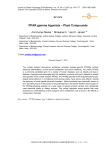
PPAR gamma agonists - plant compounds
Статья обзорная
The nuclear receptor peroxisome proliferator activated receptor-gamma (PPARg) controls adipocyte differentiation, as well as lipid metabolism and insulin sensitivity. As a result, PPARg is a promising candidate gene for a variety of human diseases, such as obesity and type 2 diabetes. Hyperglycemia associated with the metabolic syndrome and type 2 diabetes is treated with agonists of the nuclear receptor PPARg. The PPARg agonists of the thiazolidinedione type, despite being effective in normalizing blood glucose levels, have serious side effects, making the discovery of novel ligands extremely important . Natural products have historically proven to be a promising source of structures for drug development, and recent research has focused on the PPARg-activating potential of a wide range of natural products derived from traditionally used medicinal plants or dietary sources. This review highlights recent studies that have advanced our understanding of this receptor's role in metabolism, with a focus on the effects of compounds in the plant
Бесплатно
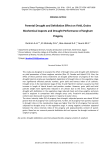
Статья научная
This study was designed to evaluate the effect of drought stress and drought with defoliation on yield parameters of three sorghum varieties (Giza 15, Dorado and Hybrid 113). Also, the effect of these parental stress treatments on drought performance of progeny of the most drought tolerant variety was investigated. Application of drought stress in the vegetative stage non significantly affected panicles number, grain yield and harvest index of all cultivars. Drought stress in the reproductive stage of Giza 15 and Hybrid 113 cultivars caused a two fold increase in length of lateral branch and panicles number. However, grain yield and total panicles weight were significantly reduced in all cultivars due to this stress. Application of drought with defoliation in the vegetative stage reduced shoot and straw weights, and grain yield in sorghum in comparison with drought stress only. Protein-N and polysaccharides content were decreased in parent grains in response to water stress. The stress intensity index (SII) of progeny from drought- subjected parents was about 30-fold greater than SII of progeny from control parents. Further, SII of progeny from parents exposed to drought stress in the vegetative stage was higher than the SII of progeny from parents subjected to drought stress in the vegetative stage. A strong negative correlation appeared between the stress intensity index of the progeny and polysaccharides content of parent grains. Based on our research parental defoliation did not improve the drought resistance of sorghum progeny.
Бесплатно
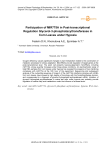
Статья научная
Oxygen deficiency causes significant changes in plant metabolism related to the coordination of metabolic processes for stress adaptation. MicroRNAs provide regulation of target genes at the post-transcriptional level. The plant cell presents hypoxia-dependent microRNAs, including miR775A, whose quantity increases under these stress conditions. An electrophoretic study of total RNA samples from corn leaves under hypoxia has revealed the presence of two interfering complexes with miR775A at the 12th hour of the experiment. Sequencing and subsequent analysis of the nucleotide sequence of image 2 of the miR775A interfering complex with mRNA from corn leaves have showed a high degree of homology with the N-acyltransferase domain, and corresponded to a fragment of glycerol-3-phosphate acyltransferase mRNA. Inhibition of glycerol-3-phosphate acyltransferase in maize leaf cells under hypoxia can probably provide regulation of cellular fatty acid metabolism under the influence of a stress factor.
Бесплатно
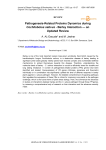
Статья обзорная
Barley is one of the most important cereal crops grown worldwide. Spot blotch caused by the hemibiotrophic fungus Cochliobolus sativus , is a destructive disease of barley leading to significant yield losses globally. Barley plants have evolved complex and orchestrated defense mechanisms to protect themselves towards this disease. Therefore, understanding the molecular basis of barley - C. sativus interaction is crucial to efficiently breed for durable and long lasting resistance. A number of pathogenesis-related proteins (PRs) genes have been identified and studied. Overexpression of PR genes (chitinase, glucanase and thaumatin) individually or in combination has significantly uplifted the level of defense response in barley plants against C. sativus pathogen. However, the detailed comprehension of signaling pathways that regulates the expression of these PRs is critical for improving crop plants to the pathogen challenge, which is the future theme of plant stress biology. Here, we summarize the advances in studies on interactions between barley and the C. sativus pathogen through these PR genes, by reviewing a comprehensive body of research on their interaction and the advances recently made
Бесплатно
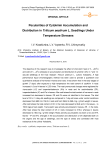
Статья научная
The objective of this research was to investigate the effect of short-term heat (2 h., +400C) and cold (2 h., +20C) stresses on accumulation and distribution of cytokinin (CK) in 7 and 14-day-old seedlings of the frost resistant Triticum aestivum L. cultivar Volodarka. A high performance liquid chromatography method has been used to provide a qualitative and quantitative analysis of hormones in leaves and roots. It was shown that in the early stages of growth (7 days) after exposure to high temperature the total content of cytokinin in roots increased 1,6 and in leaves in 2,55 times. The most pronounced changes were registered for trans -zeatin ( t -Z) and izopenteniladenozin (iPa) in roots and for zeatinriboside (ZR), izopenteniladenin (iP) and iPa in leaves. After cold stress the total content of hormone in roots increased but decreased in leaves. ZR and iPa were not identified in the leaves. The total level of CK in 14-day-old seedlings as compared to 7-day-old ones under control conditions decreased from 685,3 to 158,3 in roots and from 396,8 to 368,4 ng / g fresh weight in leaves. After cold stress the total content of CK in the roots decreased to 99,9 and in the leaves - to 195,8 ng/g of wet weight. Trans -zeatin was actively accumulated in leaves, ZR - in the roots. After heat stress the total content of CK in roots increased to 316,3, whereas in leaves decreased to 184,6 ng / g fresh weight. Roots actively accumulated cis -zeatin ( c -Z) and iPA, leaves - iP and iPa. Changes in the accumulation and distribution of CK depended both on the organs and the age of seedlings, and the type of stress and correlated with frost resistance of the cultivar Volodarka.
Бесплатно
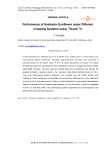
Performance of sesbania-sunflower under different cropping systems using 15N and 13C
Статья научная
A field experiment on sesbania (ses) and sunflower (sun) plants grown in monocropping and intercropping systems (1ses:1sun; 1ses:2sun, and 2ses:1sun, row ratio) was conducted to evaluate growth and N2-fixation using 13C and 15N natural abundance techniques. The results showed that 1ses:1sun surpassed the other treatments in terms of nitrogen (N) and dry matter yields (DM). However, 1ses:2sun gave the highest seed and oil production and showed the greatest N2-fixation. Sesbania plants in the 1ses:2sun fixed almost identical amounts of N2 in mono and intercropping systems. Moreover, soil N-uptake was the lowest among other treatments. These results give an advantage to the 1ses:2sun treatment over other treatments in terms of soil N consumption and N2 fixation to meet sesbania's N requirements. Nevertheless, 2ses:1sun seemed to be an inappropriate treatment. On the other hand, it could be suggested from ‰D13C data that plants in the intercropping systems appeared not to be subjected to any abiotic stress during the growing period.
Бесплатно
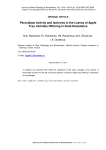
Peroxidase activity and isoforms in the leaves of apple tree varieties differing in scab resistance
Статья научная
27 species and varieties were tested for resistance to leaf scab. Changes in the activity of peroxidase enzyme and the set of enzyme isoforms in leaves of apple tree differing in resistance to this pathogen.
Бесплатно
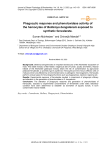
Статья научная
Background: Bellamya bengalensis is an important bioresource of the freshwater ecosystem of India. This edible mollusc is filter feeder, indigenous diet of human, poultry and fishery. Natural habitat of this freshwater gastropod mollusc bears the risk of contamination by agricultural pesticide fenvalerate, a synthetic type II pyrethroid. Hemocytes are the immuno effector cells of molluscs which are affected by environmental toxins or pathogenic microorganisms. Hemocytes perform various types of immunological functions such as phagocytosis, cytotoxic response etc. Results: Experimental exposure of fenvalerate resulted in impairment of phagocytic efficacy and alteration in the generation of phenoloxidase in B. bengalensis. Conclusion: The alteration of phagocytic response and generation of phenoloxidase of hemocytes, exposed to experimental concentrations of fenvalerate under static laboratory condition have been determined to establish as biomarker of aquatic toxicity in toxin contaminated natural habitat.
Бесплатно
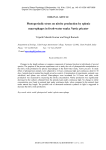
Статья научная
Changes in day length enhance or suppress component of immune function in individuals of several species. The purpose of the present experiment was to study the role of photoperiodic manipulation on the nitric oxide production by splenic macrophages in the fresh-water snake, Natrix piscator. To study effect of photoperiod, animals were subjected to 24 hour continuous light and continuous dark for 30 days. Animals kept in natural day length served as control. At termination of experiments, animals were sacrificed, and spleen was excised. Macrophages were incubated for 24 hours and nitric oxide production was measured by measuring the nitrite concentration. Nitrite production was significantly decreased to the cultures obtained from the animals kept under continuous light. No change in nitrite concentration was found in animals kept under continuous dark, when compared to the animals kept under natural day length. The possible role of decreased melatonin synthesis in light is suggested to decrease the nitric oxide production.
Бесплатно
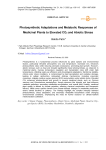
Статья научная
Photosynthesis is a fundamental process influenced by plant species and environmental factors, particularly elevated atmospheric CO₂ and temperature. Increased CO₂ enhances photosynthetic rates while reducing stomatal conductance, promoting plant growth. However, abiotic stresses such as heat and drought significantly impair photosynthesis, as observed in medicinal plants. Canopy temperature regulation and transpiration rates shift under high temperatures, affecting water-use efficiency and physiological adaptations. Membrane stability, critical under stress conditions, is compromised by lipid peroxidation and oxidative damage, leading to cellular dysfunction. Antioxidant defense mechanisms, including enzymatic responses, mitigate reactive oxygen species (ROS) accumulation under abiotic stress. Elevated CO₂ enhances photosynthesis and growth in several medicinal plants, such as Ocimum sanctum and Gynostemma pentaphyllum , though stressors like drought and heat influence metabolic pathways, secondary metabolite accumulation, and overall yield. Notably, medicinal plant quality is altered by climate variables, affecting chemical composition and therapeutic efficacy. While some species benefit from climate-induced changes in metabolite production, others exhibit declines in potency. The findings highlight the complex interplay between photosynthesis, stress adaptation, and secondary metabolite biosynthesis under changing environmental conditions, emphasizing the need for further research on climate-resilient medicinal plant cultivation.
Бесплатно
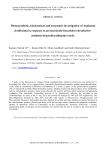
Статья научная
A study on the heterocystous, nitrogen fixing cyanobacterium, Anabaena fertilissima was carried out to investigate the effect of an organochlorine insecticide (hexachloro-hexahydro-methano-benzodioxathiepineoxide, called as endosulfan) at different concentrations of 3, 6 and 12 µgml-1 on the photosynthetic pigmentsChl-a, Carotenoids and Phycobiliproteins-phycocyanin, allophycocyanin and phycoerythrin, stress metabolites such as carbohydrates, proteins, amino acids, phenols and enzyme activities-nitrate reductase and glutamine synthetase. The insecticide- Endosulfan showed to be deleteriously affecting the activities in the cyanobacterium. As early as the 4th day, chl-a and carotenoids reduced by 38% and 20% respectively. The phycobiliproteins declined by 60%, 64% and 28% with respect to Phycocyanin, Allophycocyanin and Phycoerythrin. Moreover, Endosulfan adversely depleted the cellular activities, leading to a marked decrease in the carbohydrates, proteins, phenols and amino acids and enzymes-nitrate reductase and glutamine synthetase. Despite of deleterious effects of Endosulfan on the cyanobacterium Anabaena fertilissima, a unique regenerating ability in presence of the insecticide was observed by the end of 12 days in the lower doses of insecticide.
Бесплатно
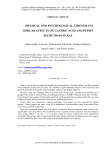
Physical and psychological stress have similar effects on gastric acid and pepsin secretions in rat
Статья научная
Stress is one of the most important health and social problems. Previous studies have demonstrated stress influence on the clinical course of a number of gastrointestinal diseases, but its physical and psychological effects on gastric acid and pepsin secretions are largely unknown. 48 male wistar rats weighing 200-250 gr were used in this study. Animals were divided into 6 groups (n=8); Control, Physical stress, Psychological stress, L-NAME+ Physical stress and L-NAME+ Psychological stress groups. In this study, electrical shock generated in a communication box was used as physical shock and the emotional stress was as psychological stress. Gastric juice was collected by washout technique. Acid output was also measured by digital titrator. Gastric pepsin and nitric oxide (NO) metabolites were quantified using Anson and Griess micro assay methods respectively. Basal and stimulated gastric acid and pepsin in physical and psychological stress groups were significantly more than others. NO metabolites level of gastric tissue in physical and psychological stress groups (286.9 ± 5.8, 287.7 ± 5.7 μmol/gr weight wet tissue, respectively) were significantly more than other groups. But no significant differences among basal and stimulated gastric acid, pepsin and NO metabolites level were seen in physical and psychological stress groups.
Бесплатно
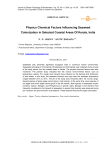
Physico chemical factors influencing seaweed colonization in selected coastal areas of Kerala, India
Статья научная
Seaweeds play extremely significant ecological roles in numerous marine communities. Seaweeds belonging to Chlorophyta, Rhodophyta and Ochrophyta were collected during course of the study period from the coastal areas of Kerala. The physico-chemical factors were also monitored. The present study indicated that the various environmental factors such as temperature, salinity, PH, oxygen and nutrients have influence on the diversity and distribution of sea weeds. In this study, the seaweed biomass was high when the seawater temperature ranged between 29°C to 30°C. The pH of the study area remained within the normal range. Several species of green algae cannot grow in high salinity. At the same time, some species of red algae and brown algae cannot grow in the low salinity. Most species of seaweeds require nutrients, Carbon, Nitrogen, and Phosphorous in specific ratios. Nitrogen is the element most frequently considered to limit growth of seaweeds. In general high diversity was observed during pre monsoon and post-monsoon at all stations. These seasons favoured the algal colonization.
Бесплатно
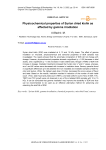
Physicochemical properties of Syrian dried Kishk as affected by gamma irradiation
Статья научная
Syrian dried kishk (SDK) was irradiated at 5, 10 and 15 kGy doses. The effect of gamma irradiation on microbial, physicochemical and sensorial properties of SDK samples was investigated. The results showed that the proximate composition of SDK did not change with dosage. However, physicochemical properties showed a significant (p
Бесплатно
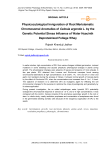
Статья научная
In earlier studies, high concentration of DPJ from various forages inhibited germination, induced mutations in some seedlings and caused phytotoxic phenotypical changes in plants during growth. The physiological changes were absence of leaves and presence of more stipules in few pea plants. DPJ obtained from Lucerne and Eicchornia crassipes found causing chromosomal aberrations at high concentrations i.e at 0.50%, 1%, 1.5% and 2% in onion and garlic root meristems during the process of mitosis. It showed normal growth of Celosia plants by the effect of Eicchornia DPJ, when the concentrations are increased from 0.1 to 1 % level. The objective of research is to determine DPJ as mutagenic agent for effecting the cell chromosomal changes for the purpose to optimize the crops physiologically and genetically by its stress application. During present investigation, the so called antipathogen water hyacinth DPJ potentiality changed the chromosomal response of Celosia at 1.5 %, and 2 % high concentrations. It was compared with the control. Celosia consists of the anomalous secondary growth in the root or stem. In mitotic study, mostly restitution prophases and unorientation of anaphases were found in the germinated seedling somatic cells because of the exogenous application of DPJ to the seeds.
Бесплатно
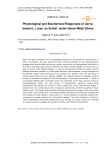
Статья научная
Biotic and abiotic stresses exert a considerable influence on the growth and reproduction of plants. Temperature, pH, light, water and various chemical pollutants are the important abiotic stresses which directly affect the survival, growth, reproduction and geographical distribution of all plants. The present study aims to determine the stress related changes of Aerva lanata (L.) Juss. ex Schult. under different habitats. A. lanata is an important herb which is widely used for different therapeutic practices. It comes under the family Amaranthaceae. The physiological and biochemical analysis were conducted on the samples from polluted (road side and sides of polluted water body) and non- polluted habitats. The analysis showed remarkable variation among the samples of polluted and non-polluted plants. The results showed that A. lanata of non-polluted habitats were unstressed which was confirmed by the least amount of proline, malondialdehyde (MDA) and high amount of photosynthetic pigments. Heavy metal quantification also showed low amount of heavy metals (Zinc, Lead, Cadmium and Nickel) in samples from non- polluted areas when compared to polluted area, where the quantity of heavy metals is high. The present study revealed remarkable biochemical changes in the plants which were grown under polluted and non-polluted habitats. Moreover, this study also indicated the accumulation of heavy metals in various parts of A. lanata collected from polluted habitats when compared to samples collected from non-polluted habitats. Thus while collecting A. lanata for medicinal purposes, the polluted habitats should be avoided. This study is also very important for researchers who investigate the changes of plants under different stress factors.
Бесплатно
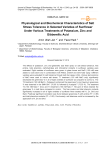
Статья научная
The effects of potassium, zinc and gibberellic acid foliar spray on salt stress tolerance, free proline, total phenolics, carbohydrates and chlorophyll contents in sunflower varieties were evaluated. Eight varieties of sunflower were grown in glass house and NaCl (150 mM) was added to roots alone and in combinations with KNO3, ZnSO4 and GA3 foliar spray. Different varieties were evaluated for salt tolerance through leaf disc assay (LDA). Various test solutions of NaCl were used to induce salt stress. T1 treatment (150 mM NaCl only) significantly decreased the greenness % in all of eight varieties of sunflower as compared to control C. The T2 treatment (150 mM NaCl + Potassium) enhanced the greenness % and maximum greenness % was observed in the SMH-0917 (76.00 %) followed by Ausigold-7 (75.50 %). The treatment T3 (150 mM NaCl + Zinc) and T4 treatment (150 mM NaCl + 100 ppm of GA3) retained the greenness % in leaf discs compared to control. The free proline and total phenolic contents significantly increased in all of eight varieties of sunflower when treated with K, Zn, GA3 and NaCl. Positively significant correlation was found between greenness % with proline (R2 = 0.86) and total phenolics contents (R2 = 0.83). Conclusively; salt tolerance could be increased by the application of K, Zn and GA3.
Бесплатно
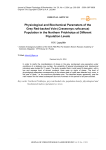
Статья научная
In order to clarify the manifestations of stress in the grey red-backed vole population under conditions of a relatively low number, the variability of several physiological and biochemical indicators was studied for 13 years. The study revealed that in most years of observation, with a low and average level of animal numbers, there were no signs of stress. The level of physiological parameters corresponding to the stress state of voles was detected only once, in the year of "peak," i.e. the maximum population size. The identified stress, apparently, was the main reason for the lowest subsequent survival of animals in this period for all years studied.
Бесплатно



